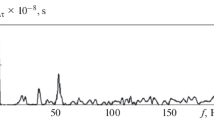Abstract
This article is concerned with the issues of the development and optimization of algorithms for the control and calculation of the torsional vibration parameters of turbomachine shaftings. For the control of shaft torsional vibrations, the discrete phase method (DPM) is used. Depending on the natural shafting vibration forms determined by calculation, the necessary number of informational surfaces (control cross-sections) with labels, which are alternating crest–valley pairs (“gears”), or holes in special perforated disks, are made along its length. The DPM features that must be considered when using it for the control of the torsional vibration parameters are observed. It is shown that the said method can only determine the mean integral angular speed values at angles of rotation of a rotor between labels in informational cross-sections, but it does not provide the direct instantaneous measurement of the shaft torsional vibration parameters. The approximation of the instantaneous torsional vibration parameters by their mean integral values leads, in case when the fast Fourier transform (FFT) is used, to significant errors, especially in the higher harmonics range. In this case, the accuracy of the angular vibration spectrum determination depends significantly on the conversion order, i.e., on the number of labels in an informational cross-section in fact. It is noted that additional errors of the FFT algorithms are caused by the use of data with nonconstant discretization frequency (data on a variable grid). The problems of the DPM determination of the harmonic amplitudes multiple to the rotation frequency (order harmonics) are discussed. It is shown that they can be determined only using angular masks of informational cross-sections. In addition, angular masks that are in compliance with the established rules help to significantly decrease the label pitch difference effect on the calculation results for the torsional vibration parameters. The algorithms for the conversion of the measurement results are presented. The relations for the determination of the angular amplitudes (swirl angles) of a shaft in control cross-sections are obtained with consideration of the chosen number of labels and the torsional vibration frequency. Examples of the results for the numerical modeling and analysis of shaft torsional vibrations using the proposed algorithms are given.










Similar content being viewed by others
REFERENCES
I. E. Zablotskii, Yu. A. Korostelev, and R. A. Shipov, Non-Contact Oscillation Measurements of Turbomachine Blades (Mashinostroenie, Moscow, 1977) [in Russian].
M. I. Kiselev, N. V. Novik, and V. I. Pronyakin, “Registration of the parameters of the torsional oscillations of a turbogenerator shaft,” Izmer. Tekh., No. 12, 34–36 (2000).
M. I. Kiselev, N. A. Zroichikov, V. I. Pronyakin, and Ya. V. Chivilev, “A precision investigation of turbine unit operation using optic-electronic instruments,” Teploenergetika 53, 868–872 (2006).
M. A. Biyalt, P. E. Chernenok, E. V. Bochkarev, A. V. Kistoichev, and E. V. Ur’ev, “Actuality and problems of monitoring the torsional oscillations of turbine unit shafts at power plants,” Elektr. Stn., No. 8, 50–57 (2013).
A. Z. Zile, D. V. Taradai, S. B. Tomashevskii, and Yu. A. Shuranova, “Studies of torsional oscillations of turbine unit shafts,” Elektr. Stn., No. 10, 40–48 (2013).
K. N. Borishanskii, “The method of monitoring the vibrational state of a turbine unit under operating conditions,” Tyazh. Mashinostr., No. 11–12, 4–9 (2015).
E. V. Bochkarev, D. S. Kshesinskii, A. A. Plotnikova, A. M. Deminov, A. V. Kistoichev, M. A. Biyalt, and E. V. Ur’ev, “Development of principles for the implementation of stationary monitoring of torsional oscillations of turbine unit shafts,” Tyazh. Mashinostr., No. 11–12, 35–39 (2015).
A. N. Morozov and A. L. Nazolin, “Physical fundamentals of creation of optical-electronic systems of measuring control of tortional vibrations of a turbine unit shaft,” Fiz. Osn. Priborostr. 5 (3), 30–39 (2016).
E. V. Ur’ev, S. V. Zhukov, A. V. Kistoichev, M. A. Biyalt, E. V. Bochkarev, and D. S. Kshesinskii, “On torsional oscillations of shafts of high-power steam turbine units under operating conditions,” Nadezhnost Bezop. Energ. 10, 131–139 (2017).
A. G. Dobryakov and A. A. Zaitsev, “Development of a torsional oscillation control subsystem for ASKVM “VKBROBIT 300” for the turbo unit st. no. 9 TPP “TETs-22” of PJSC ‘Mosenergo’,” in Proc. 9th Int. Sci.-Tech. Conf. Problems of Vibration, Vibro-Adjustment, Vibration Monitoring and Diagnostics of Equipment of Power Plants, Moscow, Nov. 22–24, 2017 (Vyssh. Teplotekh. Inst., Moscow, 2017).
I. Sh. Zagretdinov, A. G. Kostyuk, A. D. Trukhnii, and P. R. Dolzhanskii, “Destruction of the 300-MW turbine-generator unit at the Kashira District Power Station: Causes, consequences, and conclusions,” Therm. Eng. 51, 345–355 (2004).
A. G. Kostyuk, V. V. Frolov, A. E. Bulkin, and A. D. Trukhnii, Steam and Gas Turbines for Power Plants (Mosk. Energ. Inst., Moscow, 2008).
N. A. Makhutov and A. L. Nazolin, “Diagnostics of states and substantiation of safety of turbogenerators of critical and strategically important power plants,” Probl. Bezop. Chrezvychainykh Situat., No. 2, 3–24 (2016).
K. N. Borishanskii, “Features of registration of auto-oscillations of blades of high-power steam turbines,” Tyazh. Mashinostr., No. 10, 16–21 (2017).
D. R. Brillinger, Time Series: Data Analysis and Theory (Holt, Rinehart, and Winston, New York, 1974; Mir, Moscow, 1980).
M. Kendall, Time Series (Griffin, London, 1973; Finansy Stat., Moscow, 1981).
P. W. Bridgman, Dimensional Analysis (Yale Univ, New Haven, 1922; Regulyarnaya Khaoticheskaya Din., Izhevsk, 2001).
L. I. Sedov, Similarity and Dimensional Methods in Mechanics (Nauka, Moscow, 1977) [in Russian].
A. Z. Zile, D. V. Taradai, S. B. Tomashevskii, and Yu. A. Deomidova, “On torsional oscillations and fatigue strength of low-pressure rotors,” in Proc. 9th Int. Sci.-Tech. Conf. Problems of Vibration, Vibro-Adjustment, Vibration Monitoring and Diagnostics of Equipment of Power Plants, Moscow, Nov. 22–24, 2017 (Vyssh. Teplotekh. Inst., Moscow, 2017).
Author information
Authors and Affiliations
Corresponding author
Additional information
Translated by E. Petrova
Rights and permissions
About this article
Cite this article
Ur’ev, E.V., Bochkarev, E.V., Biyalt, M.A. et al. Study of Torsional Vibrations of Turbomachine Shafts: Part 1. Algorithm Optimization for the Determination of the Parameters of Natural and Forced Torsional Vibrations of Shafts. Therm. Eng. 66, 43–54 (2019). https://doi.org/10.1134/S004060151812011X
Received:
Accepted:
Published:
Issue Date:
DOI: https://doi.org/10.1134/S004060151812011X




